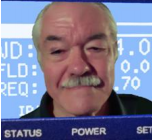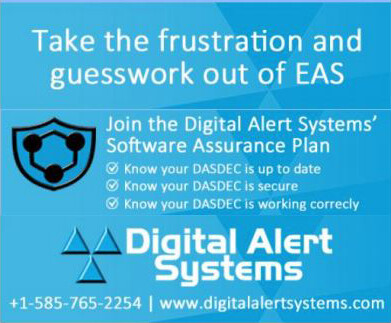NPT 2021 – Everything You Need to Know

[June 2021] After a year’s absence, the National Periodic Test (NPT) of the EAS returns this Summer. Just to ensure you are ready, Dave Kline addresses a couple of key points.
What time of the year do most of us dread?
That time where you do not know what people want, is a big headache, and has us scrambling around like crazy at the last minute? If you said holiday shopping, you would be correct. But I had something else in mind.
The NPT. Coming to an EAS decoder on Wednesday (yes, Wednesday) August 11th at 2:20 PM EDT. (In case of a major problem, the backup date is August 25th.)
After a one-year hiatus due to the pandemic the NPT is back, and the bad news is that it is back with a vengeance. It is that day when everyone in the US and territories gets to be a part of the big EAS national test.
This year, as in 2019, the NPT will be distributed via the PEP system, AKA the “daisy chain.” But is it really? We all monitor (or are supposed to) a PEP source directly, if possible. And in my mind, one link does not a chain make. However, many stations do get the tests and alerts via the local LP-1 or LP-2. So unless you have not been receiving alerts from a PEP source (they are identified in the alert text) this news is not all that bad. If unsure, just check with your local LECC or state SECC.
This year there seems to be some good news about the test, something that has been on our wish list for a few years now: an extension of time for submitting Form Two, the “day of test” report.
FORM-TWO DEADLINE EXTENDED
In past years the FCC wanted us to submit Form Two by 11:59 PM-EDT on the day of the test.
Rather than being frustrated that it takes longer than a New York minute (New York/EDT… see what I did there?) to file your report, you now have a whole extra day! This year the report is due no later than August 12th.
That being said, I still think it would be a good idea to submit your report as soon as you can, especially if you only mange one or two boxes.
I would also advise you to read the FCC notice and make up your own mind about the deadlines for Form Two. The wording is a bit clunky. It took me three times through the part about deadlines before I got it. (I am no lawyer, nor do I play one on the radio.) So read it for yourself and make up your own mind.
Hopefully this will give those with a lot of EAS boxes some extra time. It may also help alleviate some of the server “pile-ups” we had seen in the past. The FCC has promised that their IT contractor will have sufficient server capacity this time to prevent the logjam that made filing Form Two a real pain for many folks.
Another point of concern for many is where a contractor has a large number of stations for which he must file. The FCC has some provision for that, and invites filers to call Maureen Bizhko at the Policy and Licensing Division at the Public Safety and Homeland Security Bureau, at (202) 418-0011 for assistance should it be needed. Her email is:
maureen.bizhko@fcc.gov
THE OTHER FORMS
At this point, we might want to consider a few words on From One and Form Three.
The purpose of Form One is to verify each station’s correct location and contact information. Now, you might say, the FCC should know each station’s information.
However, the reality is that even if the station’s electronic and physical aspects are exactly as in the FCC data-base, personnel changes do happen and the FCC wants to be sure who to contact for any questions/issues.
Form One is open right now, and needs to be filed by July 6th. You can log in here on the ETRS and do it in a few minutes. Probably the most difficult part will be recalling the login and password that had been set up in previous years. (When you do find it, or register, put it safely in the files where you will find it next time. If you need assistance, the FCC set up this trouble-shooting page.
FORM THREE
Form Three is the one the FCC wants in order to assess how many stations actually received and relayed the NPT.
The FCC Public Notice (above) specifies filling this form out before September 27th. That is six weeks after the intended test date, and a month after the fallback date. Should be plenty of time.
Basically, if you have never filled out this form, it is asking details from you such as from where you got the NPT, did your station relay it, was the audio good, bad, or missing, etc.
A QUICK CHECK LIST
Some quick checks that you should do before August 11th:
- Ensure your EAS equipment can receive and process the NPT code, including the “six zeroes” for the national location code.
- Check to see that the EAS equipment software and firmware is at the most recent version.
- If necessary, review the State EAS Plan for monitoring assignments and ensure EAS equipment is properly configured to monitor those sources.
- Ensure the EAS equipment clock is set to the official time provided by the National Institute of Standards and Technology. If it does not do it automatically, do it manually. Now.
- Ensure a copy of the EAS Operating Handbook is located at normal duty positions, at EAS equipment locations, or is otherwise immediately available to operators.
- Ensure that the EAS Operating Handbook has been customized to specify what actions are to be taken by operators upon receipt of the test alert – tailoring them to your specific facility.
- Review the 2021 ETRS Form One filing to identify and make necessary updates to the information previously provided.
SOME FINAL NPT 2021 COMMENTS
A final thought as I wrap up: Treat this as if is a one-time thing, meant to be for this year only. Do not expect this to be how it will always be without the FCC making some changes. That may be in the works, but we will not know until later.
We hope your August EAS stress has just gotten a bit easier. You will have a whole day, or more to submit Form-Two. You only have to worry about Eastern Daylight Time as a reference when the test takes place. No worries about adjusting to other time zones to submit the Form.
And rather than be late for dinner on the day of the test, perhaps you can take care of your report over coffee the next morning.
Thanks to the FCC for hearing us and granting our wish.
– – –
Dave Kline, is an engineer at KVNO / University of Nebraska at Omaha. You can contact Dave at: dkline@unomaha.edu
– – –
Has this article been of value to you? The one-time-a-week BDR Newsletter is designed to let you know when more are posted. You are invited to subscribe: takes just 30 seconds if you click here.

